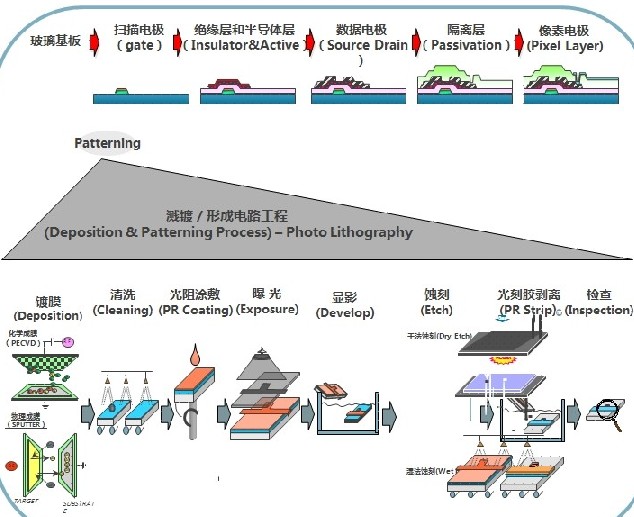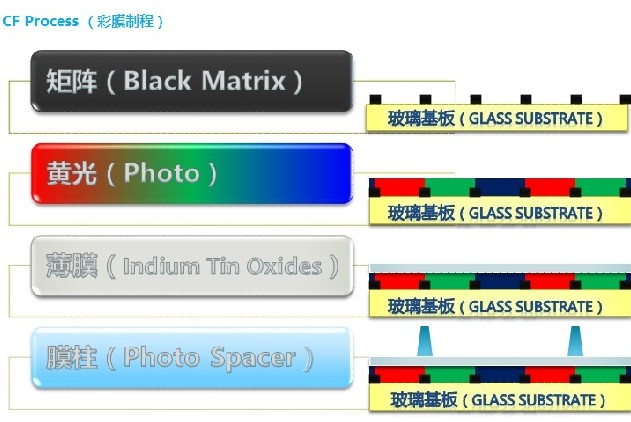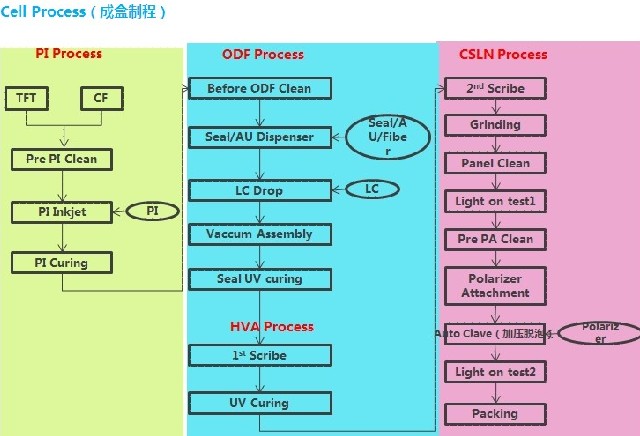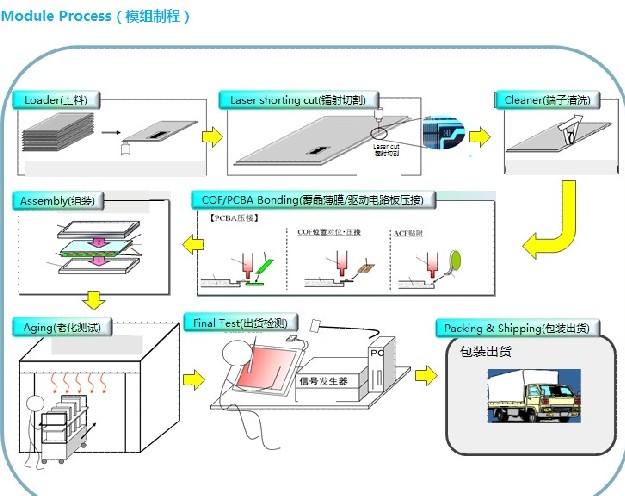TFT (Thin Film Transistor) LCD is a thin film field effect transistor LCD, which is a type of active matrix liquid crystal display (AM-LCD). Liquid crystal flat panel display, especially TFT-LCD, is currently the only display device that catches up with and exceeds CRT in comprehensive performance such as brightness, contrast, power consumption, life, volume and weight. It has excellent performance, good large-scale production characteristics, high degree of automation, low raw material cost, and broad development space. It will quickly become a mainstream product in the new century and a highlight of global economic growth in the 21st century.
Main Features
Unlike TN technology, TFT display uses "back-through" illumination - the imaginary light source path is not from top to bottom like TN liquid crystal, but from bottom to top. This is done by setting a special light tube on the back of the liquid crystal, and the light source is transmitted upward through the lower polarizer when irradiated. Since the electrodes of the upper and lower layers are changed to FET electrodes and common electrodes, the performance of the liquid crystal molecules will also change when the FET electrodes are turned on. The purpose of display can be achieved by shading and transmitting light, and the response time is greatly improved to about 80ms. Because it has a higher contrast and richer colors than TN-LCD, and the screen update frequency is also faster, TFT is commonly known as "true color".
Compared with DSTN, the main feature of TFT-LCD is that a semiconductor switch device is configured for each pixel. Since each pixel can be directly controlled by a dot pulse, each node is relatively independent and can be controlled continuously. This design method not only improves the response speed of the display, but also can accurately control the display grayscale, which is why TFT colors are more realistic than DSTN.
Key Benefits
With the maturity of TFT technology in the early 1990s, color LCD flat panel displays developed rapidly. In less than 10 years, TFT-LCD quickly grew into the mainstream display, which is inseparable from its advantages. The main features are:
(1) Good usage characteristics
Low voltage application, low driving voltage, solid use safety and reliability are improved; flat, thin and light, saving a lot of raw materials and use space; low power consumption, its power consumption is about one tenth of CRT display, reflective TFT-LCD is even only about one hundredth of CRT, saving a lot of energy; TFT-LCD products also have specifications, models, sizes, varieties, convenient and flexible use, easy maintenance, update, upgrade, long service life and many other features. The display range covers the application range of all displays from 1 inch to 40 inches and large projection planes, and is a full-size display terminal; the display quality ranges from the simplest monochrome character graphics to high resolution, high color fidelity, high brightness, high contrast, and high response speed video displays of various specifications; the display modes include direct view, projection, perspective, and reflection.
(2) Good environmental protection characteristics
No radiation, no flicker, no harm to the health of users. In particular, the emergence of TFT-LCD electronic books and periodicals will bring mankind into the era of paperless office and paperless printing, triggering a revolution in the way humans learn, spread and record civilization.
(3) Wide scope of application
It can be used normally in the temperature range from -20℃ to +50℃, and the low temperature working temperature of the temperature-hardened TFT-LCD can reach minus 80℃. It can be used as a mobile terminal display, a desktop terminal display, and a large-screen projection TV. It is a full-size video display terminal with excellent performance.
(4) High degree of automation of manufacturing technology
Large-scale industrial production has good characteristics. The TFT-LCD industry technology is mature, and the yield rate of large-scale production reaches more than 90%.
(5) TFT-LCD is easy to integrate and upgrade
It is a perfect combination of large-scale semiconductor integrated circuit technology and light source technology, and has great potential for further development. Currently, there are amorphous, polycrystalline and single-crystal silicon TFT-LCDs, and in the future there will be TFTs made of other materials, both glass substrates and plastic substrates.
TFT Process
1. Array Process




Previous article:LCD and AMOLED compete for high performance and low cost
Next article:Technical challenges and solutions for wireless hotspots in high-density areas
- Popular Resources
- Popular amplifiers
- High signal-to-noise ratio MEMS microphone drives artificial intelligence interaction
- Advantages of using a differential-to-single-ended RF amplifier in a transmit signal chain design
- ON Semiconductor CEO Appears at Munich Electronica Show and Launches Treo Platform
- ON Semiconductor Launches Industry-Leading Analog and Mixed-Signal Platform
- Analog Devices ADAQ7767-1 μModule DAQ Solution for Rapid Development of Precision Data Acquisition Systems Now Available at Mouser
- Domestic high-precision, high-speed ADC chips are on the rise
- Microcontrollers that combine Hi-Fi, intelligence and USB multi-channel features – ushering in a new era of digital audio
- Using capacitive PGA, Naxin Micro launches high-precision multi-channel 24/16-bit Δ-Σ ADC
- Fully Differential Amplifier Provides High Voltage, Low Noise Signals for Precision Data Acquisition Signal Chain
- LED chemical incompatibility test to see which chemicals LEDs can be used with
- Application of ARM9 hardware coprocessor on WinCE embedded motherboard
- What are the key points for selecting rotor flowmeter?
- LM317 high power charger circuit
- A brief analysis of Embest's application and development of embedded medical devices
- Single-phase RC protection circuit
- stm32 PVD programmable voltage monitor
- Introduction and measurement of edge trigger and level trigger of 51 single chip microcomputer
- Improved design of Linux system software shell protection technology
- What to do if the ABB robot protection device stops
- Learn ARM development(14)
- Learn ARM development(15)
- Analysis of the application of several common contact parts in high-voltage connectors of new energy vehicles
- Wiring harness durability test and contact voltage drop test method
- From probes to power supplies, Tektronix is leading the way in comprehensive innovation in power electronics testing
- From probes to power supplies, Tektronix is leading the way in comprehensive innovation in power electronics testing
- Sn-doped CuO nanostructure-based ethanol gas sensor for real-time drunk driving detection in vehicles
- Design considerations for automotive battery wiring harness
- Do you know all the various motors commonly used in automotive electronics?
- What are the functions of the Internet of Vehicles? What are the uses and benefits of the Internet of Vehicles?
- Take the test on TI.com.cn and enjoy 10% off!
- How to measure the waveform capture rate of an oscilloscope and a tutorial
- 【NXP Rapid IoT Review】+ Review Summary
- Examples of capacitor applications in power supply design (recommended for collection)
- Has anyone used Bosch's PM sensor?
- THGBMAG5A1JBAAR Where is this product used?
- [NXP Rapid IoT Review] +1. Unboxing and Getting to Know the Rapid IoT Kit
- Impedance matching design principles and methods
- How to Design the Parameters of Second-Order Low-Pass Filter Circuit
- LED color temperature adjustment circuit collection

 TC52N4149ECTRT
TC52N4149ECTRT













 京公网安备 11010802033920号
京公网安备 11010802033920号